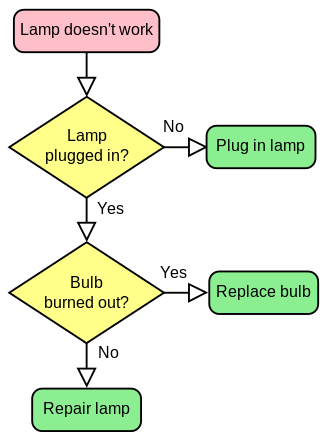Procedural thinking: Difference between revisions
Mr. MacKenty (talk | contribs) No edit summary |
Mr. MacKenty (talk | contribs) No edit summary |
||
| Line 8: | Line 8: | ||
# Procedural thinking is used when performing CPR to save someone's life - you follow a series of steps (call for help, check breathing, check airway, check circulation, decide if you perform CPR) | # Procedural thinking is used when performing CPR to save someone's life - you follow a series of steps (call for help, check breathing, check airway, check circulation, decide if you perform CPR) | ||
# When you print something on a school printer, you follow a series of sequential steps (choose what to print, click print, choose a printer, go to the printer, and then scan your barcode). | # When you print something on a school printer, you follow a series of sequential steps (choose what to print, click print, choose a printer, go to the printer, and then scan your barcode). | ||
# If a lamp is broken, you might follow these steps in the flowchart below: | |||
[[File:LampFlowchart.png]] | [[File:LampFlowchart.png]] | ||
Revision as of 05:03, 27 September 2016

Procedural thinking[1]
Procedural thinking is a disciplined method of thinking in sequence, in order and logically. Procedural thinking can be reflected in a flow chart. Some examples below may help you better understand procedural thinking:
- Following a recipe requires procedural thinking because you must follow the steps in order
- Putting together Ikea furniture requires procedural thinking because you usually follow the steps in order
- Procedural thinking is used when performing CPR to save someone's life - you follow a series of steps (call for help, check breathing, check airway, check circulation, decide if you perform CPR)
- When you print something on a school printer, you follow a series of sequential steps (choose what to print, click print, choose a printer, go to the printer, and then scan your barcode).
- If a lamp is broken, you might follow these steps in the flowchart below:
Standards[edit]
- Identify the procedure appropriate to solving a problem.
- Evaluate whether the order in which activities are undertaken will result in the required outcome.
- Explain the role of sub-procedures in solving a problem.
